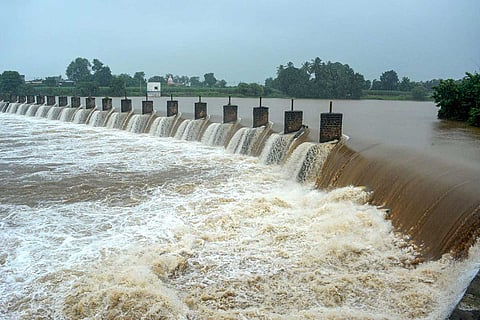

Just days after Karnataka Chief Minister BS Yediyurappa took charge in July 2019, he was faced with his first test in office when heavy rains caused devastating floods and landslides in Karnataka. Over 60 people died and several lakh residents were displaced in the worst floods to hit the state in decades. Without a cabinet in place, Yediyurappa worked with bureaucrats when the floods occurred.
The disaster was particularly severe in the basin of the Krishna river in the northern part of the state. Parts of neighboring Maharashtra, which fall within the river’s basin, too reported floods. While heavy rains contributed to the disaster, government officials said that the lack of regulated dam water discharge aggravated the damage.
“When there were rains last year (in 2019), officials decided to store water in our dam. This is because the dam had filled up only 4 or 5 times in the last forty years. But when the rains continued to increase, we had no choice but to release the water and this increased the damage due to the floods,” say a dam engineer working at the Malaprabha dam.
Data compiled by the South Asia Network on Dams, Rivers and People (SANDRP), an informal network which focuses on dams in India, showed that most dams in the Krishna basin were close to their full capacity during the first week of August 2019, when the region received above normal rainfall.
Dam water regulation
Drawing on the experience of 2019, government officials decided to regularly discharge water from the dams in the basin this year.
“We decided that in principle, we will not keep more water in the dam and as soon as it reaches 85% storage levels, we decided to maintain inflow and outflow. The water level did not reach dangerously high levels this year partly because of the lesser rain but also because of the regulation of water storage in dams,” says GS Srinivasa Reddy, a consultant with the Karnataka State Disaster Management Authority (KSDMA).
State government officials decided to focus on the preparation for the floods as early as April this year, despite the COVID-19 pandemic restricting movement and disrupting plans. “Despite the COVID-19 situation this year, flood preparedness was also a high priority for the state and it started in April itself,” says Manoj Rajan, Commissioner of the Karnataka State Disaster Management Authority (KSDMA).
In early July, a meeting was held between government officials in Karnataka and Maharashtra to ensure that the failings of the previous year did not repeat. “Lessons learnt from last year were incorporated to improve dam management, which has enabled us to plan for an integrated system and to coordinate with Maharashtra,” Manoj Rajan says.
Hourly monitoring of dam levels via WhatsApp
In Karnataka, WhatsApp groups were created to track the information of water levels in each dam in the Krishna and Cauvery basin. Field engineers of different dams and government officials were part of the group through which information about water levels was shared every three hours. The officials also monitored rain forecasts through 7,000 weather stations in the state to project the likely inflows and outflows of the dams.
“One official from Karnataka was posted in Solapur and shared information from Maharashtra on the group and this helped warn gram panchayats about the possibility of floods; something that was not in place last year,” says Srinivasa Reddy.
Lesser rainfall was reported in the state during the monsoon season this year, which was another crucial factor that helped the officials. “Last year, the rainfall was concentrated over a period of a few days at the start of August but that was not the case this year and it was spread out over a longer period. The quantum of rainfall is one aspect but its spread is also crucial,” says Rakesh Singh, Additional Chief Secretary, Water Resources Department.
He adds that officials could take better decisions this year because they managed to map how much time it takes for water to flow between dams. “This year, we had a better understanding of the time taken for the water to reach a particular dam once it is discharged. The estimations were more accurate this year,” says Rakesh Singh.
Village level committees
In addition to the disaster response measures taken by the government, 912 vulnerable gram panchayats were identified in 13 districts and plans were drawn up to ready a disaster management team in each village. “These committees were trained to respond to the release of water from the dams. Danguras (a musical instrument) were used to warn people and those at risk were evacuated early this year. The committees maintained lists of how many residents were at risk and how many among them were elderly and where they would be evacuated to, in the event of a flood,” Manoj Rajan says.
In 2020, Karnataka reported 36 deaths in rain-related incidents while 6,716 people were displaced and sheltered in relief camps in the state. In comparison, the disaster in 2019 displaced more than 6 lakh residents in the state while over 1,100 relief camps were opened.
In spite of the relative success of dam water regulation this year, there are still lingering concerns. Environmentalists and government officials alike are concerned about encroachment along the bank of the Krishna river. “Despite the regulation of the water levels in the dam, we have noticed that the encroachment on the river banks has reduced the width of the river from 135-200 metres down to 10 metres in some spots,” says a dam engineer at the Malaprabha dam.